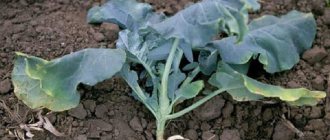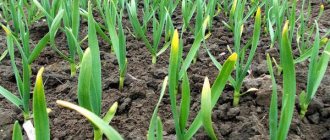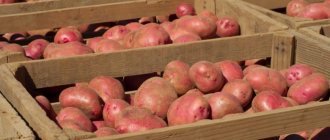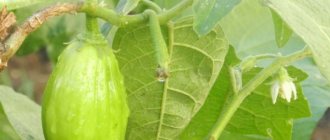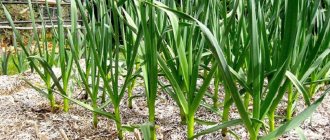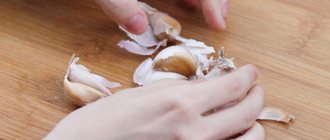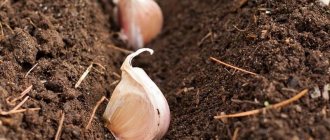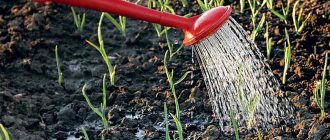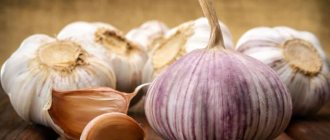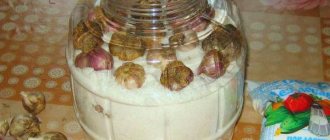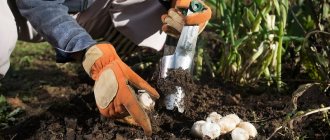Sometimes you may encounter a situation where the garlic crop begins to deteriorate during storage. We will tell you what the problem is and how to deal with it.
The quality and keeping quality of garlic largely depend on the condition of the plant during the growing season. Garlic can get sick due to unfavorable weather conditions, violation of agrotechnical measures, untimely and incorrect preventive treatment. The disease does not appear immediately, so there is a high probability that if at least one head was infected at the time of harvest, the disease will spread to healthy garlic in storage, destroying the entire crop.
Most often, garlic suffers from fungal and bacterial diseases. How to recognize and prevent them?
Green mold
This disease usually appears 2-3 months after the start of storage. When infected with green mold, the garlic cloves become limp and yellow sunken spots appear on them. Gradually, the disease spreads inward, the cloves become soft, wrinkled and emit a characteristic musty smell. A white coating forms on the spots, which over time acquires a bluish-green tint.
The fungi that cause the disease persist in the soil, on plant debris, indoors and containers. They actively develop at high humidity and air temperatures from –5 to 36°C.
Possible reasons
If you notice alarming symptoms in plants in the garden, it is important to ask the question: “Why does garlic rot?” The reasons may lie in insufficient care or violation of planting rules. This often happens because you did not observe crop rotation or sacrificed disinfection of the site for the sake of quickly preparing the beds.
Among the most common causes of crop damage, fungal diseases are undoubtedly the leading ones. Fusarium wilt of garlic, for example, develops at high humidity when moisture stagnates in the soil. If this happens during a hot period, then the plant has very little chance of withstanding the onslaught of the fungus.
The longer the disease remains untreated, the more fatal the consequences: the cloves become soft, rot forms in them, the root system dies under the influence of the fungus, and then the entire plant withers. Fusarium spreads through soil and water, so pretty quickly all the plants in the garden become infected.
Another reason why garlic rots is white rot of the bottom. The disease actively develops with abundant watering, when the soil moisture is too high, however, unlike fusarium, low air temperatures are required for its spread. Winter garlic is at risk in the spring, when the snow begins to melt.
If penicillosis (green mold of garlic) appears in the garden bed, this may also be the cause of rotting. Watery brown spots form on the bottom and outer husk. Individual cloves in the bulb are affected, gradually withering and becoming covered with small depressed spots of dark yellow color.
As you can see, the main range of reasons lies in the increased humidity of the environment, as well as the lack of preventive care for plantings.
Penicillosis
This disease affects not only garlic, but also onions, vegetables, and fruits. Light yellow or brown watery spots appear on the heads (mainly on the outer scales and bottom), which eventually become covered with bluish-green mold. When the affected clove is cut open, brownish-gray watery spots are visible.
The disease appears 2 months after harvest. If garlic is stored in a dry place, infected heads will dry out quickly.
Most often, penicillosis actively develops when garlic heads are mechanically damaged during storage. Pathogenic organisms (conidia) enter through cuts.
Bacterial rot
Bacteriosis develops on garlic plantings at any stage of the growing season, causing rotting of the affected cloves.
A characteristic symptom is yellowish-brown sores on garlic bulbs, which quickly spread to the entire surface.
Expert opinion
Stanislav Pavlovich
Gardener with 17 years of experience and our expert
Ask a Question
Attention! Sometimes the infection manifests itself in the transparency of the garlic cloves, which then turns into mucus, which has an unpleasant, distinct odor.
Ways to fight:
- Planting garlic in one area at intervals of four years.
- Application of the preparation “Hom” for soil treatment.
- Sufficient application of phosphorus fertilizers.
- Deep plowing of the land.
To effectively combat bacterial rot, a formaldehyde solution (1%) is used when preparing to plant garlic cloves.
How to protect garlic from diseases?
It is very difficult to stop the development of the disease, so only preventive measures are effective.
- Maintain crop rotation (plant garlic in its original place no earlier than after 3 years).
- Place garlic beds away from other onion crops.
- During the growing season, promptly remove affected plants.
- Follow the watering schedule and do not allow the plantings to thicken.
- After harvesting, clear the fields of plant debris.
- Before storing garlic, thoroughly disinfect the storage.
- Use healthy planting material.
- Dry the harvested garlic thoroughly and store only the heads without visible damage.
- Store garlic in a dry place at a temperature of 1-3°C and air humidity no more than 75%.
- When you notice the first signs of rot, carefully sort and remove all affected heads.
- 1-2 days before planting, treat garlic cloves with a biofungicide in accordance with the instructions included with the preparation.
Follow these preventative measures and properly care for the plant during the growing season. Then the garlic will remain healthy during storage.
Garlic is a leader in use in various areas of human life.
Garlic was known to mankind even before our era. Where has it not been used! It was valued in cooking for its piquancy, and by folk healers for its ability to treat many diseases. Sorcerers and witches used it as protection against damage, the evil eye, and repelling evil spirits and other evil spirits.
Nowadays, this vegetable is used as a seasoning in cooking, as a means of helping in the treatment of colds, cardiovascular diseases, as well as in the treatment of the gastrointestinal tract.
Garlic easily copes with various infections, expels parasites from the human body, and improves blood flow. Therefore, every owner asks the question: how to keep garlic from drying out at home so that it brings more benefits.
Indeed, it is important not only to protect it from drying out, but also to preserve its medicinal and taste qualities. It is known that the strongest healing properties last until the New Year. But even until spring it can be used to treat colds, and also used in cooking as a spicy seasoning.
Determining the onset of the disease
In what cases does garlic rot, and when is it necessary to sound the alarm about the beginning of the rotting process? Often a sign of the beginning of garlic rotting in the garden is prematurely yellowed tops. However, gardeners rarely pay attention to this sign. Therefore, the use of fungicides (preparations that prevent rotting) occurs late.
Early yellowing of garlic tops can also be a sign of potassium deficiency in the soil, which is why attention to this factor is not given enough attention. The main reason for garlic rotting in the garden is unfavorable and damp weather conditions. Their result is the appearance and development of fungal infections in the area where garlic grows.
1. Downy mildew is a dangerous virus that affects garlic.
— dense plantings;
- sudden temperature changes;
— too high humidity.
How to recognize a diseased plant? Garlic leaves are initially covered with yellow or brown spots, in place of which a gray coating appears. In advanced forms of the disease, the entire surface of the leaves is infected, and the virus penetrates into the head itself. When the fungus penetrates the bulb, it stops growing and developing and subsequently dies completely.
How to fight powdery mildew? One of the important factors is prevention and treatment of seed material. When preparing teeth, pay attention to their scales. If it is too dense, then this indicates a possible infection. Such teeth are not suitable for planting.
Powdery mildew found on growing garlic? At the first signs of damage, all damaged areas of leaves should be removed. Next, the plantings are treated with copper sulfate. After harvesting, all heads must be thoroughly dried.
2. Leaf rust: garlic leaves turn yellow in spring
Many summer residents complain about yellowing of the leaves of winter garlic. Despite good care, watering and fertilizing, the leaves still die off. It's all about the virus that affects garlic. Rust is spread by fungi that spread over the entire surface of the plant.
How to identify rust on leaves? In diseased plants, raised yellow spots appear on the leaves, which darken over time and lead to drying out of the leaves.
Methods to combat rust fungus begin even before the cloves are planted. All seed material must be processed and disinfected. In adult plants, the affected leaves are torn off and the garlic is sprayed with Bordeaux mixture.
3. Fusarium - yellowing of individual garlic leaves in spring. What to do and how to recognize the disease?
A fungal disease of garlic can be identified by individual yellowed leaves or brown stripes on them. If the disease is advanced, the damage will spread to the entire plant and the bulb, which rots. The affected heads cannot be stored; they become covered with a white coating.
To combat Fusarium rot of garlic, Bordeaux mixture and copper sulfate are used. Spraying of plantings is carried out at intervals of several weeks.
4. Neck rot of garlic: diseases during storage
It is quite difficult to recognize this disease during the growing season. As a rule, when storing an already harvested crop, it is manifested by softness of the neck and the appearance of gray spots on the bulb. Affected heads of garlic have a specific smell of rot.
The disease develops in overfed soils. When using large doses of nitrogen-containing fertilizers, garlic is affected by neck rot. All plant feeding should be stopped a month before harvest. Garlic harvesting is carried out only in dry weather. The heads are thoroughly dried before storing. It is better to store the crop at a temperature of 0 degrees. This will stop the development of neck rot.
5. Black mold: garlic heads dry out
This fungal disease develops in the heads during storage of garlic. As a rule, conditions favorable for the development of mold are too high a storage temperature. The damaged bulb dries out completely. If you break the head, you can find black dust under its skin. These are fungal spores that are transferred to other bulbs.
You can get rid of the disease using the drug “Fitosporin”, which is used to treat planting material, storage and planting of garlic. After harvesting, the crop is dried well, the necessary storage conditions are observed and dried bulbs are removed in a timely manner.
Eye burn? What to do? In case of eye burns, the victim requires mandatory consultation with a doctor, but before this is obtained, it is necessary to apply first aid measures, which include cooling the damaged area. For faster healing, use...
6. Green rot: storage problems
The development of green rot occurs when the humidity during storage is too high. At the sites of cuts or dents, a pathogenic fungus forms, which affects the entire bulb. Rot can be recognized by greenish spots.
Timely disinfection of the storage and its ventilation, and good drying of the crop will help get rid of green rot.
We invite you to familiarize yourself with: Austin Rose Planting Scheme
7. White rot: a fungal disease of the roots
The leaves of winter garlic turn yellow and die, and a white mycelium with a coating forms on the roots. At the same time, black spots appear on the head of garlic, which lead to rotting. The plant can be saved only at the initial stage of the disease. All diseased leaves are removed and sprayed with antifungal drugs.
Fungal diseases of garlic spread quite quickly and can destroy the entire crop. At the slightest sign of damage, you must immediately use available control methods. To prevent all fungal diseases, rot and yellowing of garlic leaves, mulching of the soil is carried out in early spring. Last year's compost is used for these purposes.
Correct choice of seed material
Often, diseases and other reasons why garlic rots do not appear without reason. I would like to believe that this is just bad luck or that circumstances have developed this way, but the fact is that the conditions of collection or storage were violated.
It is extremely important to select seed material. It is unacceptable to use cloves that are rotten, moldy or have wormholes. They become the source of fungal spores, which subsequently infect the soil and all neighboring plants.
If you carry out preventive treatment of seed material with fungicidal preparations, the likelihood of introducing the disease into the garden bed is significantly reduced. You can use “Fitosporin”, “Topsin-M”, the solution of which is sprayed on the cloves before sowing or soaked the day before.
We suggest you familiarize yourself with: Honey lemon garlic mixture: benefits and harms
You cannot take cloves for planting if they are taken from a diseased plant.
Seed material must be processed before planting. You can wash the cloves in a saline solution by dissolving 3 tablespoons of table salt in 5 liters of water, and then dipping the cloves in it for 1-2 minutes. It is recommended to soak for a day in a pink solution of potassium permanganate or a solution of copper sulfate.
You can also reduce the chances of rot by simply choosing a variety that is resistant to fungal diseases. These include:
- Jubilee Gribovsky is a medium-ripening variety that produces an arrow. The growing season lasts from 80 to 125 days, the bulbs grow small, weighing up to 50 grams.
- Zubrenok is a medium-ripening variety that produces an arrow. A large onion reaches a weight of up to 75 grams, 5-6 cloves.
- Novosibirsk is a variety with a medium ripening time and does not shoot out. The growing season takes up to 80 days.
Do not forget that the quality and healthy development of garlic is influenced by the place where it is planted. What you should never do is plant this crop twice in a row in the same place. It is this reason that ranks second in the list of answers to the question “why did the garlic begin to rot?”
In rare cases, it is possible to grow aerial bulbs and then one-toothed ones in one place, but in this case it is necessary to carry out preventive treatment of the beds with fungicides and closely monitor the condition of the plants. You should not plant garlic next to potatoes, since this crop stimulates the development of Fusarium wilt in all plants surrounding it.
In addition, the planting site should not be in a low-lying area where water lingers. Remember that high humidity creates an ideal environment for the development of fungal spores. The site can additionally be fertilized with a mixture of nitrate (200 grams), potassium chloride (200 grams) and superphosphate (600 grams) per 10 square meters. It is imperative to maintain a distance between planted cloves of at least 10 centimeters, the depth should not be less than 4 centimeters.
